Synopsis: The classic 1998 gory D-Day movie Saving Private Ryan is a triumph of war cinema that lesser filmmakers have attempted to imitate countless times in the following decades up to the present day. Saving Private Ryan practically defined the entire genre of American war films, but also helped destroy it, perhaps irreversibly.
Steven Spielberg’s Saving Private Ryan wowed audiences around the world from the first moment it hit theaters. The epic war film was so good. It was too good. The movie has a terrible and wildly destructive message, and wonderful cinematography makes that message even more malignant and spread it across the entire film industry like a virus.
As one of the most accomplished filmmakers of our era armed with a huge budget, Spielberg had all the material imaginable to depict World War II as an inspiring and patriotic narrative of what those heroes did, and more importantly, why they did it. But he didn’t. Even more strangely, he deliberately didn’t.
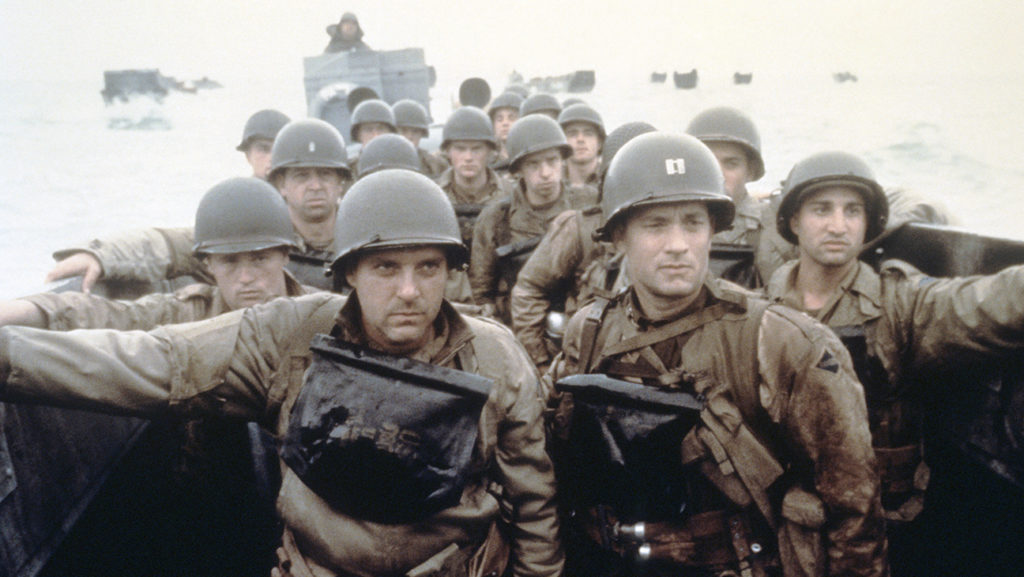
Saving Private Ryan is a great war movie, but it’s not a patriotic movie. It’s the opposite of a patriotic movie. It’s an unapologetic condemnation of patriotism.
In this two-part review. In this opening part, I’ll be taking a look at the movie from the following vantage points:
1) It is a masterpiece of cinema; here’s what Saving Private Ryan got right.
2) A rant about shaky cam, because I just can’t help myself.
3) Saving Private Ryan is technically superb, but has a lot of problems, and those problems turned into awful precedents that seem to have tainted the American film industry like a boot on a human face… forever.
With these topics thoroughly addressed, that will pave the way for the second part of my Saving Private Ryan review, it’s a spectacularly bleak and culturally counterproductive interpretation of the patriotic “why” people fought in World War II. Like the annoying battle scene tropes I gripe about in Part 1, this infuriatingly bad take has permeated the American film industry, which was already suffering from ideological decay. Actual straight-faced war movies celebrating heroism against the Axis Powers are few and far between but do happen. For example, the 2019 release Midway. But that movie got slapped down from all directions and croaked at the box office.
The grim reality of the situation is that the era of rousing patriotic flicks (whether they were dark tales of peril or comedies that didn’t take themselves too seriously yet still strove to teach a meaningful and upbeat message) is effectively over. An even more unpleasant possibility needs to be considered, though I won’t claim that it is undisputed fact. American audiences, us as a collective people, just don’t want to hear those stories anymore. We can have “chicken, egg” debates about whether this was grassroots disillusionment, a sway in public opinion influenced by Hollywood agitprop, or some combination of both, but ultimately it makes little difference. The toothpaste is out of the tube.
Now let’s dive into Part 1 of my rambling little review.
This movie is indeed a masterpiece of cinema
Saving Private Ryan’s opening battle sequence shocked and mesmerized viewers with an unapologetically gruesome and chaotic depiction of American soldiers storming the beaches of Normandy.
Movies, even ones based on true events, are difficult to gauge for accuracy. Cinematic stories about the terror and confusion of battle are even more difficult to evaluate without having actually experienced them.
This question was answered for us by none other than WWII combat veterans themselves. Many teared up during the Normandy scene, and others had to leave the theater entirely. Among the heroes of the Greatest Generation, there was widespread agreement that Spielberg’s imaginative and impressively shot reenactment resembled the real thing with disturbing accuracy.
Before going any further, I cannot overstate the significance of this praise, and how rare it is. To my recollection, Platoon is the only other movie in recent history to achieve such high-level praise by the soldiers from that war. Though it isn’t so surprising that Platoon was so good, after all it came from the memories of a man who survived desperate close-quarters combat in the real battles he portrayed on screen.
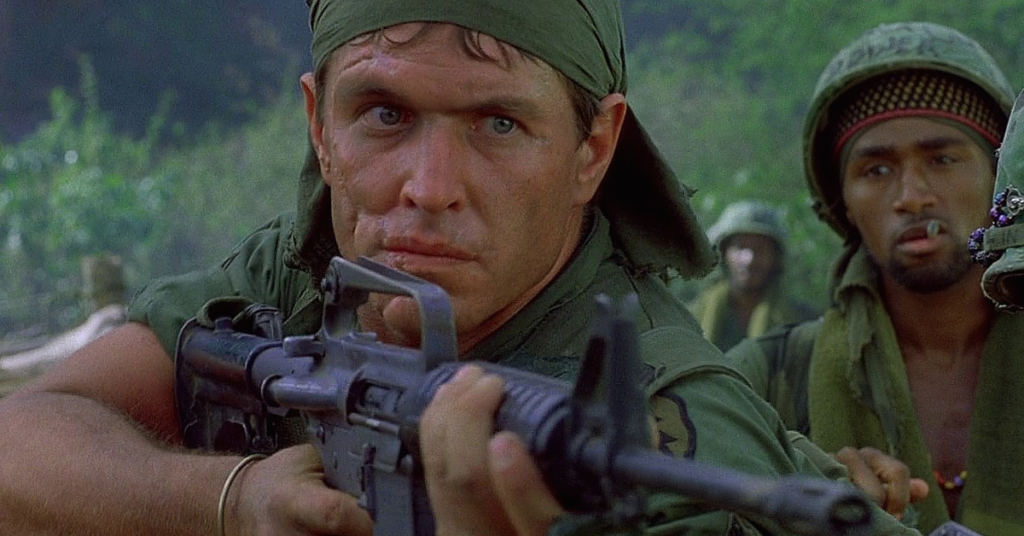
It is equally important to understand that a battle scene good enough to give veterans flashbacks isn’t a simple feat of stunning CGI, props, and blood and gore. It’s all about capturing the emotion and esprit de corps everyone felt as they slogged through raking machinegun fire. Not only is it possible for a battle scene to fall flat, it’s easy to fail disastrously.
There might be no better example of such failure than the epic Stalingrad movie Enemy at the Gates; a Western story that wowed Western audiences simply because we didn’t know any better. Russian Stalingrad veterans watched Enemy at the Gates and were so completely enraged they (unsuccessfully) petitioned their government to ban it. I can’t say I blame them. Right from its opening scene, the movie depicts Red soldiers as cowardly cannon fodder who try to run away and get mowed down by their own side, and that tone is maintained for the duration of the movie. Though Enemy at the Gates was tolerated when it released in 2001, but at some point after that someone in the Kremlin must have lost his patience. Nowadays, when Hollywood liberals puke out yet another piece of smug anti-Russian garbage (Like The Death of Stalin) it gets banned almost instantly.

An angry but necessary note on shaky cam
Before going any further, let’s talk about that shaky chaotic camera wobble that’s so awesome and cool in war movies. I have to say this because, apparently, there are teeming masses of indie and student filmmakers who need this explained to them. This movie had a lot of camera shake, especially in the opening Omaha battle scene, but this started an unfortunate trend of lots of people trying to imitate Spielberg not because they’re as good as him, or even that they like the camera-shake effect, but because they’re lazy, are attempting to cover up a low budget production, or have rushed CGI from an underpaid third party FX studio and need to confuse the audience so they don’t notice, or some combination of these.
Look at this picture:
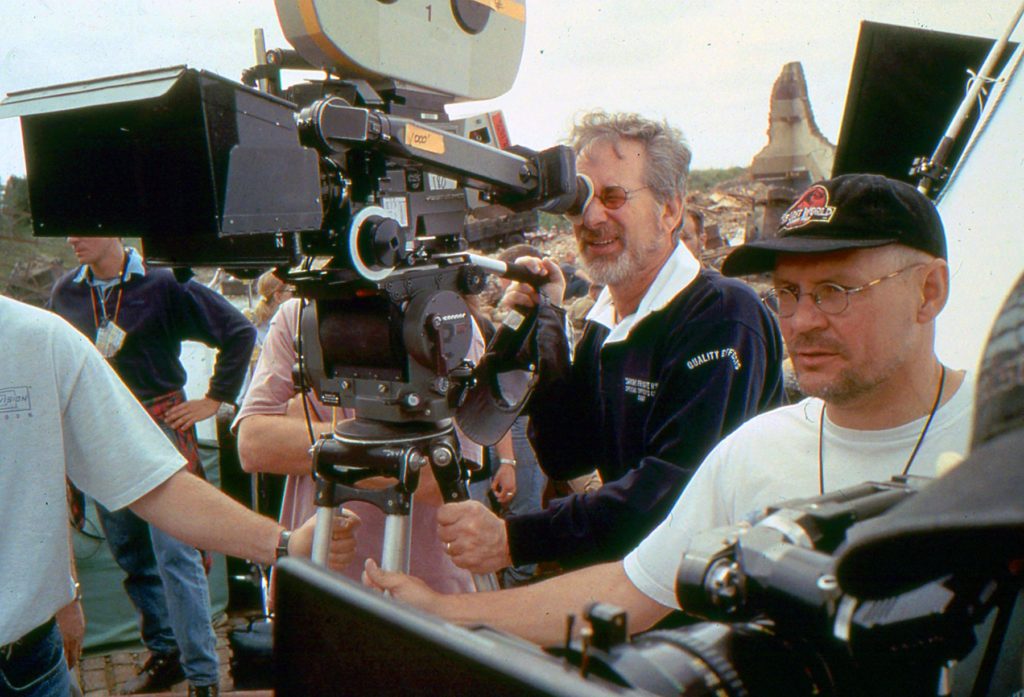
See that? Tripod! Spielberg filmed everything the normal (sane) way. The shake was added in post-production. In 2020 (or the current year you’re reading my article), this is especially easy with awesome tools including Premiere Pro, After Effects, and Final Cut Pro. Drop your footage into the editing pane, select your trusty pen tool, draw some squiggly lines with keyframes, and boom, you just recreated Saving Private Ryan. Congratulations, Mr. Spielberg Jr.
No, seriously. Heed my words. The Blair Witch Project sucks, and all the movies imitating it somehow suck even more. Please, I’m begging you, stop recording your movies with a camcorder, and get a cameraman who’s somewhat competent, or at least has a steady hand and isn’t a meth head you found in the gutter so deep into withdrawal he can’t drink a glass of water without spilling it. Then go get a decent DSLR full-frame camera (you can even go mirrorless if you’re feeling brave), ideally one that’s 4K (but remember 4K isn’t an excuse to just crop all your shots rather than compose them correctly to begin with), buy, rent, or borrow a couple lenses, and please for the love of God go invest in a tripod.
I know, I know. Look, I get it. You’re just planning to set up an IMDB page and sell your crap to Netflix for $50, a half-empty pack of chewing gum, and an expired Dominos coupon. But I still might accidentally watch your movie because Netflix took away the star rating system and replaced it with an algorithm that no one understands and is always wrong. So humor me and get the tripod. If you need lessons on how to add shake in post, watch Captain Disillusion on YouTube. He’s very good and has funny jokes too. Or get a Lynda subscription. Just… get… something.

Now it’s time to nitpick because I’m a jerk
The battles in Saving Private Ryan are so intense, many WWII veterans in theaters couldn’t watch them all the way through. This is most likely because Spielberg accurately captured the terror, adrenaline rush, and general confusion of being an individual soldier at Omaha Beach. But this doesn’t mean Spielberg accurately portrayed the battle, the battlefield, or even the soldiers accurately.
While the Omaha Beach landing scene is impressive, it’s 99% an incomprehensible mish-mash of the following ingredients, completely at random:
-Gore.
-Mud.
-Sand (I hate sand. It’s rough, course and gets everywhere).
-Nazis (I hate those guys).
-Guns going bang-bang.
– Medics with impressively modern first aid bags but no idea how to triage.
-Guys running while on fire but forgetting they’re next to water and could get in it by taking one step left or right, or literally any other direction besides straight forward.
-Ninety bajillion people get mowed down by a spray of bullets before they can even leave the landing craft because war is hell, and also because their boat drivers are idiots and stopped over the “no parking” zone directly in front of a German machinegun. I guess this looks cooler than if they did the sensible thing and stopped several hundred meters away from the shoreline where everyone could disembark outside the effective range of small arms fire. This happens to be what the real boats did. Stopping right in front of machineguns has a negative impact on the morale of your passengers.
-During a sequence shot in dramatic slow motion, a German shell lands close enough to Tom Hanks to splatter him with bloody water, and presumably blow out his ear drums, rattle his noggin around like sloshy jello, and cause traumatic brain injury… but he’s okay. He walks it off. No, really, he’s fine. The movie would be kind of boring if it was just two hours of a cute nurse patiently trying to teach him how to write the alphabet in crayon.
-A soldier was apparently hazed for losing his rifle so many times that he literally gets his arm blown off but is careful to take it with him so Sergeant Smith doesn’t yell “Private Smeckers, you dumb shit! How you gonna salute the sir with your arm Christ knows where on the beach? Too late to look for it now, I guess. Your liberated dick greaser is seagull food by now. Go mop all the rainwater off the motor pool and think about what you did!”
-Another soldier takes a ricochet to his helmet and is so impressed he takes the helmet off to show his buddy then gets hit by a second bullet to the forehead, killing him instantly. This is intended as an astute moment of black humor to make the audience chuckle but is really just mean-spirited and unfair to the poor guy because keeping his helmet on would have made no difference whatsoever. Helmets aren’t bulletproof, a glancing blow is blind chance, the odds of which happening twice in a row would be a million to one, especially since his helmet was damaged by the first impact.
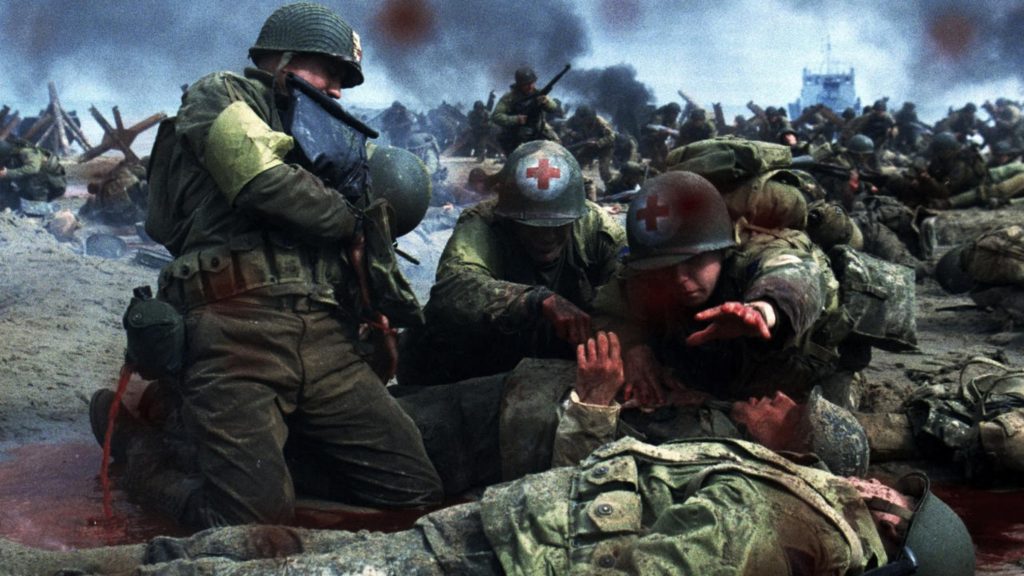
.-Yet another soldier has a flamethrower strapped to his back. The flamethrower guy sneezes gets shot by a stray bullet and explodes, killing everyone nearby. This is a thing that happens when flamethrowers get shot. In fact, this is what all weapons do when they get shot. Even tanks. Army equipment’s inability to sustain even slight damage without catastrophically exploding was an Achille’s Heel that the government kept as a closely guarded secret for decades after the war.
-To silence a German machinegun nest, Tom Hanks heroically develops the most annoyingly difficult, hazardous, and complicated attack plan ever, which involved a sniper, grenades, shaving mirrors on k-bars, and those cool WWII explody tube thingies. This is a parallel universe in which naval gunfire, planes, mortars mounted on the landing craft like 20 feet behind him, and literally everything else which might have been useful to Tom’s squad in that situation – and were in fact used in the real Omaha landing – don’t exist in this universe. Or maybe he got conked on the head harder than he realized and forgot that there might be alternatives to crawling under machinegun fire to reach grenade-tossing range, uphill. Random fun fact: almost every single defensive gun position at Omaha was destroyed by barrages from the naval destroyers. Crawling up to destroy enemy guns with grenades is dumb when you can just… not do that.
I understand I’m being kind of nitpicky, so I’ll stop there. The second big battle scene in the movie, the last stand at the bridge, I’ll leave alone. I won’t comment on anything I found odd in it, like how not a single German soldier could crane his head to look up… no, okay, sorry. I’m stopping now.

In an earlier entry, I praised Battalion for filming continuous action with convincing choreography on an individual level while interspersing high angle “bird’s eye view” camera shots so the viewer can keep track of the grueling but refreshingly gender-inclusive bloodbath between Russian women and German men. Wait, I’m not sure if that is supposed to be a victory for gender equality or not. Eh, the woman soldiers were proud to sacrifice their lives and Western feminists were proud to watch them give their lives, so… hurray for equality, I guess.

Another example – specifically about D-Day as a matter of fact, is The Longest Day. Now in fairness, Spielberg has that film beat in certain ways, thanks to having a few extra decades of progress in his favor. To name one example, blood and gore is pretty annoying to film. I’m guessing that it is also harder to resurrect a “dead” extra after you dumped a barrel of spaghetti on his head. The Longest Day production didn’t quite have room in the budget for enough hamburger meat and strawberry jam to show legs and intestines flying everywhere (And let’s be honest, Spielberg didn’t either, that was all just a grab for publicity. He depicted those Mortal Kombat finishing moves for about two minutes in the opening beach scene, then never again. From that point onwards, soldiers almost always die from neat little bullet holes and sad face).
However, that timeless classic did beat Spielberg when it comes to scale. I appreciate the spectacular battle dioramas The Longest Day pulled off while also capturing the ground-level drama of small groups and individual soldiers on all sides.
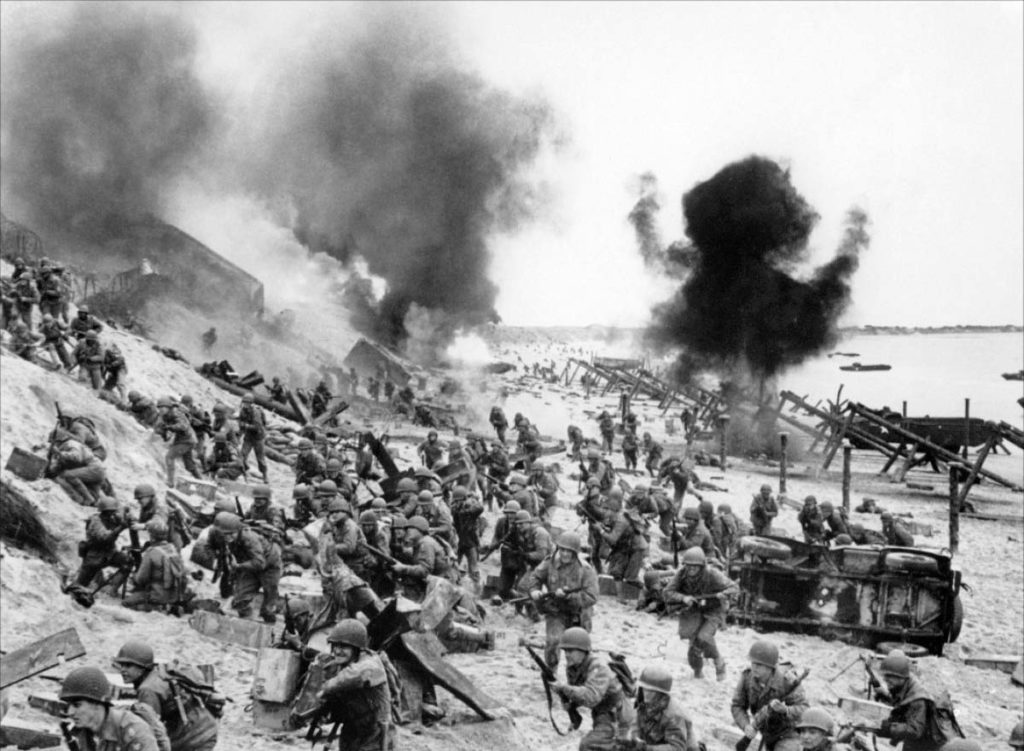
This is a special – no – I take that back, a basic attribute which should always be in a war movie. An attribute that Saving Private Ryan doesn’t ever once display, not even by accident. This is, from a technical standpoint, the biggest problem with Spielberg’s depiction of combat in his most epic of epic of war movies. For reasons absolutely beyond me, Spielberg and virtually all the 21s t Century American cinematographers to walk in his footsteps, have a phobia of high-level camera shots.
In the entire film, he stubbornly refuses to provide his audience with any sense of scale, proximity, or even a basic sense of what in the ever-living hell is going on. Good Lord, why? Just because the soldiers at Omaha were confused doesn’t mean that I want to be confused. This is a movie, not a video game. It’s not “cheating” to let the audience see what both sides are doing in relation to each other. I solemnly swear I won’t jump into the screen and warn the German general that some American rangers are flanking his guns on the Eastern cliff face.
In the Omaha scene it’s small-scale chaos – is the American force two dozen men or two thousand? Who knows, and Spielberg won’t share that with us. The only time we get a glimpse of the sprawl of American troops, thanks, and landing craft, is when we’re looking from the POV of a German machine gunner.
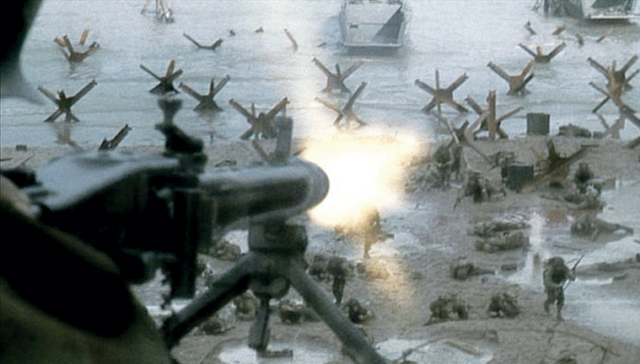
This really isn’t a particularly good vantage point for judging scale, but I’ll take what I can get. It’s also disappointing. The shot is too narrow to see anything beyond a couple platoons of unhappy American infantry and a couple boats. That’s it? That’s all Spielberg could be f-ed to show us?
Not only that, it’s kind of a dumb setup. I’ll admit that I’m not familiar with the geography of Omaha Beach, except for some photos I hastily Googled before writing this garbage. Like this one:

Why does Spielberg depict the Omaha landing zone like it’s a ten by ten-foot cranny on the cliffs that roughly three guys can stand in without getting wet? Isn’t that kind of a dumb place to try to land an amphibious assault? It’s also a pretty bad setup for defense too, because all the German machinegun positions shown in the movie, while being nicely set up to mow down enemy invaders, are also horrendously exposed.
Not only is the movie’s sense of size and spatial awareness are all kinds of fubar, time itself is twisted beyond all reason. I’m all for fast-paced action, but Spielberg acts like battles all take about two minutes then they’re over. Yes, this could in theory be done with modern weapons. The problem is that those modern weapons are held by squishy people who are allergic to death and prefer to hide in safe spots and wildly shoot all over the place, only hitting each other once in a while. That’s why the D-Day landings all dragged on for hours upon hours. Most of the GI’s on the beach were content to stay behind cover and not thrilled about the prospect of charging into machinegun and artillery fire. Not that you would know this from Saving Private Ryan, in no small part due to the fact that Spielberg put all the Americans in such a ridiculous kill zone, they would all clearly be dead within a couple of minutes.
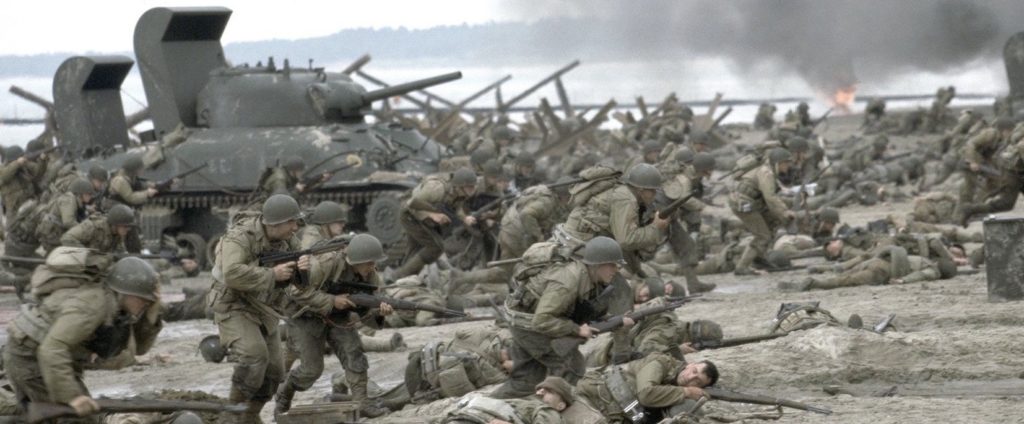
Joe: The tanks don’t actually do anything.
What makes this problem of size, scale, and time exponentially more terrible is that it was done by (God damn it!) Spielberg. Every time he does something, it becomes something of an industry standard. The denizens of Hollywood should praise Allah that he doesn’t abuse this power, because I sure as hell would. If I were Spielberg, I would go through an entire film production without ever once using toilet paper, declaring that any self-respecting visual storyteller should do this. That would be a huge (and painful) inconvenience for me, but totally worth it.
The best part is I wouldn’t even need to explain why. I could just say that stupid drivel while collecting my 27th Oscar and watch a thousand heads bob up and down in mindless agreement. A few months of agonizing itch between my cheeks would be worth the satisfaction of knowing that I just condemned thousands of insufferably smug celebrities to copying my dumb lack of hygiene until the end times, or at least the fall of American Civilization, whichever comes first.
No, I’m just kidding – I would only use my power for good. Probably.
Part 2 coming soon: the point of Saving Private Ryan is that there is no point
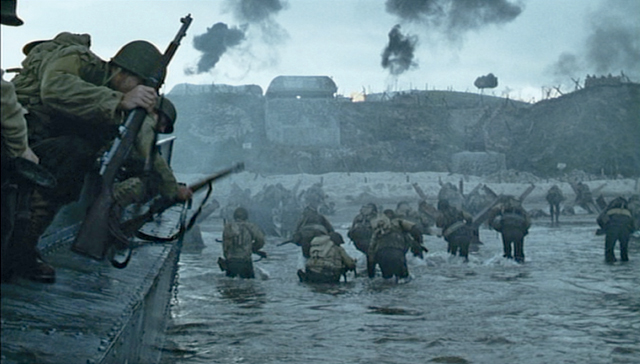
Relax, Phil. It’s an observation post and wasn’t actually right there by the beachhead like in the movie.
While this is, if you haven’t noticed already, a pretty harshly-worded review, I would be delusional to claim that Saving Private Ryan isn’t an exciting and well-executed war flick. And I also said as much in the body of the review already.
Saving Private Ryan has a reputation, and a fair one, for being so graphically violent, but I would strongly disagree with any accusations that any of this is done tastelessly, or for gratuitous or self-gratifying purposes.
Now as Part 2 of this review will spell out, I’m not a fan of the whole… literally the title of the movie and what it’s about. Saving Private Ryan is a silly mission, but this movie is best enjoyed for the journey, not the destination, especially since the destination is, for lack of a better word or if there is one it’s not coming to me at the moment, dumb.
The German baddies get a little incompetent near the end, but that’s a staple of virtually all WWII movies, and Saving Private Ryan is, thankfully, not too heavy-handed with its nerfing of the Nazi war machine.
The Longest Day aged gracefully, considering it came out in 1962!
A line-up of heavy hitters delivers a great performance, and… wait, what am I doing? Just watch the darn thing if you somehow haven’t already. And if you did see it already, see it again.
I’ve seen various B&W and color remastered versions floating around, you just have to look and go with your personal preference.
The only other war movie created in roughly the same template as Longest Day that comes close to matching it is, in my humble opinion, A Bridge Too Far. That one is definitely worth a watch too.
Ian Kummer
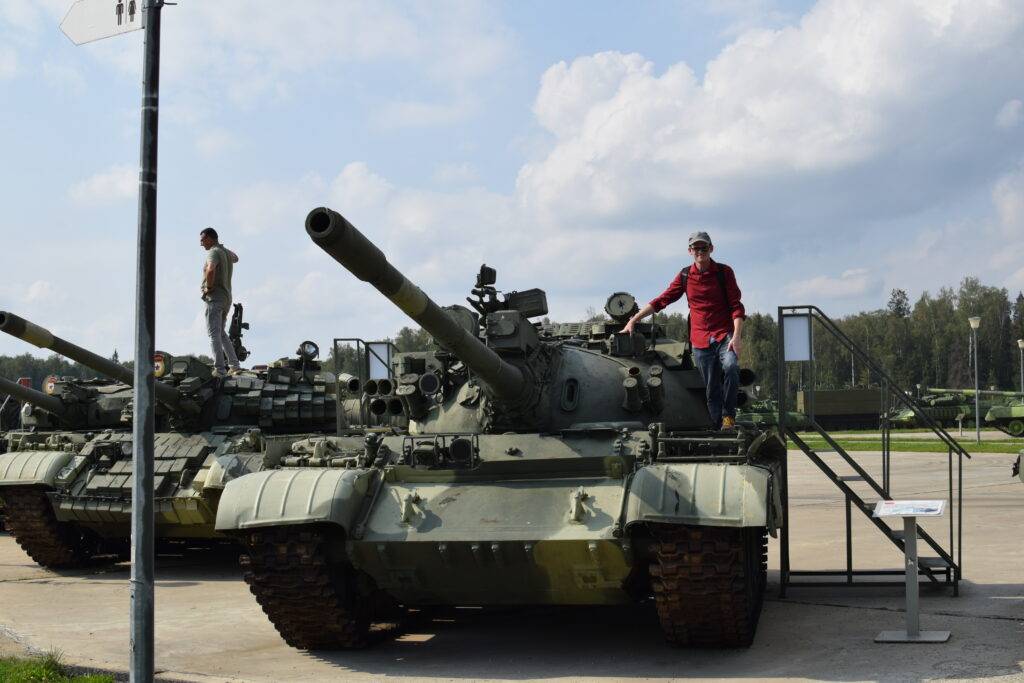
Support my work by making a contribution through Boosty
All text in Reading Junkie posts are free to share or republish without permission, and I highly encourage my fellow bloggers to do so. Please be courteous and link back to the original.
I now have a new YouTube channel that I will use to upload videos from my travels around Russia. Expect new content there soon. Please give me a follow here.
Also feel free to connect with me on Quora (I sometimes share unique articles there).

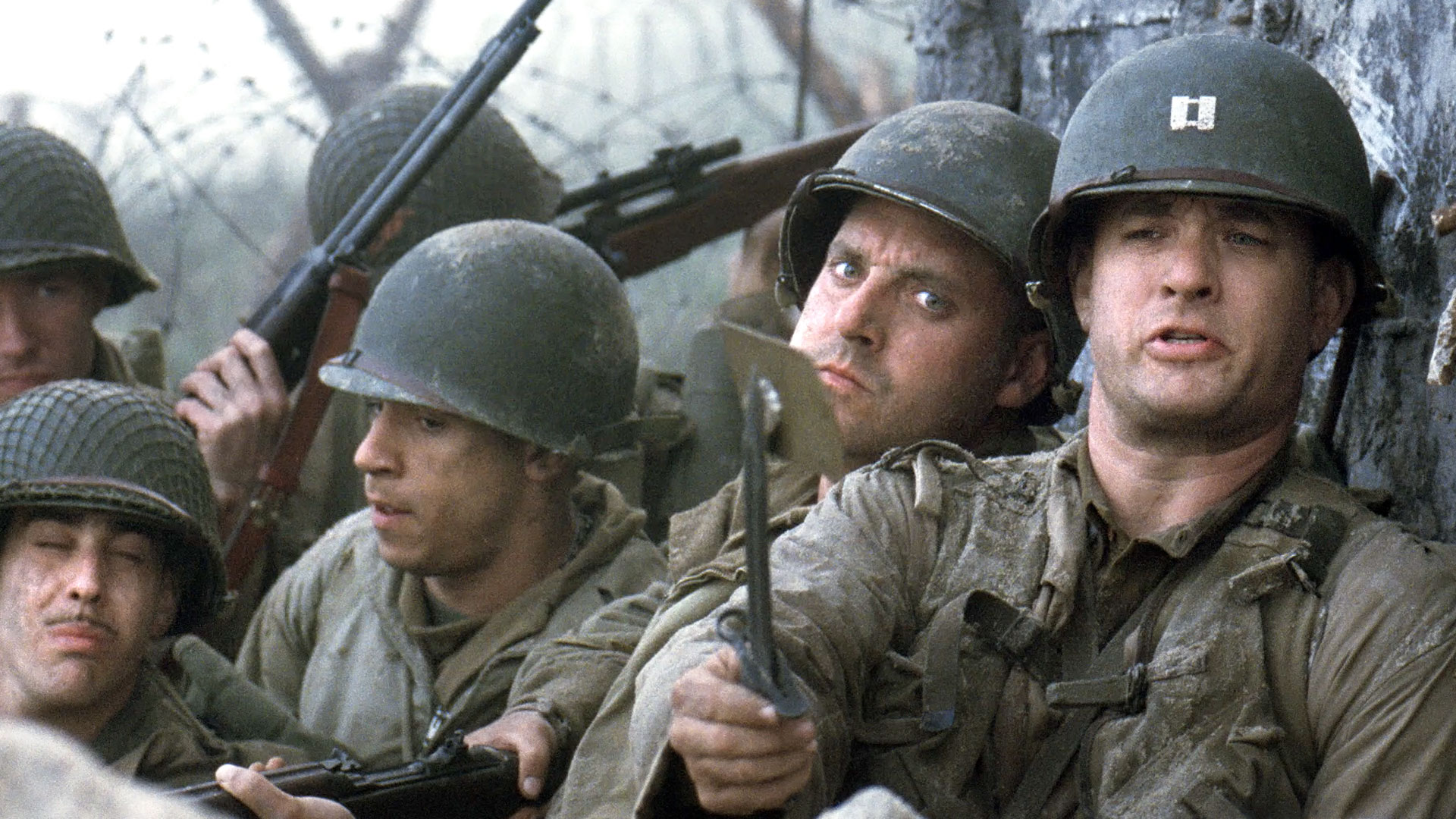
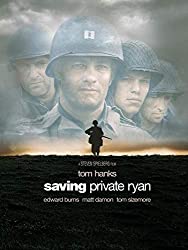
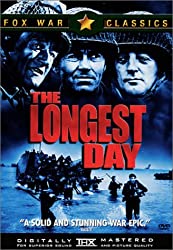

I’d love to hear your thoughts on the BAND OF BROTHERS mini-series, as well as its precursor BATTLEGROUND.
I'd love to hear your thoughts on the BAND OF BROTHERS mini-series, as well as its precursor BATTLEGROUND.